Franklin III (CV-13)
1944–1964
Named for the two previous U.S. Navy ships, the ship-of-the-line and the screw frigate, that carried the name Franklin.
III
(CV-13: displacement 27,100 tons; length 872'; beam 93'; extreme width at flight deck 146'6"; draft 28'7"; speed 33 knots; complement 3,448; armament 12 5-inch, 48 40-millimeter, 57 20-millimeter; aircraft 80; catapults 2; class Essex)
The third Franklin (CV-13) was laid down on 7 December 1942 at Newport News, Va., by Newport News Shipbuilding & Dry Dock Co.; launched on 14 October 1943, and sponsored by Lt. Cmdr. Mildred A. McAfee, USNR, Director of the Women Accepted for Volunteer Emergency Service (WAVES).
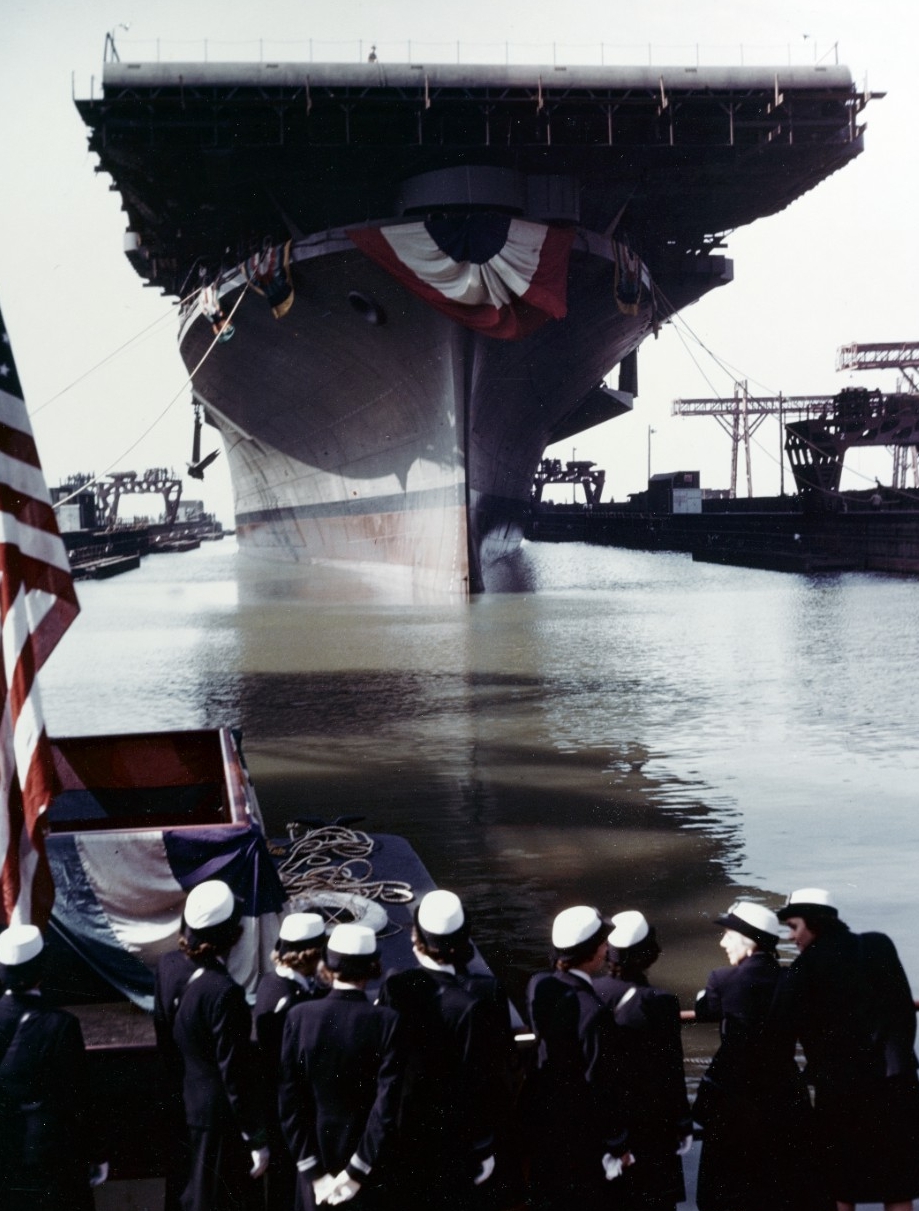
“Big Ben” as her crew affectionately called her, was commissioned at the Norfolk Navy Yard, Portsmouth, Va., on 31 January 1944, Capt. James M. Shoemaker in command, and fitted out there for the majority of February 1944.
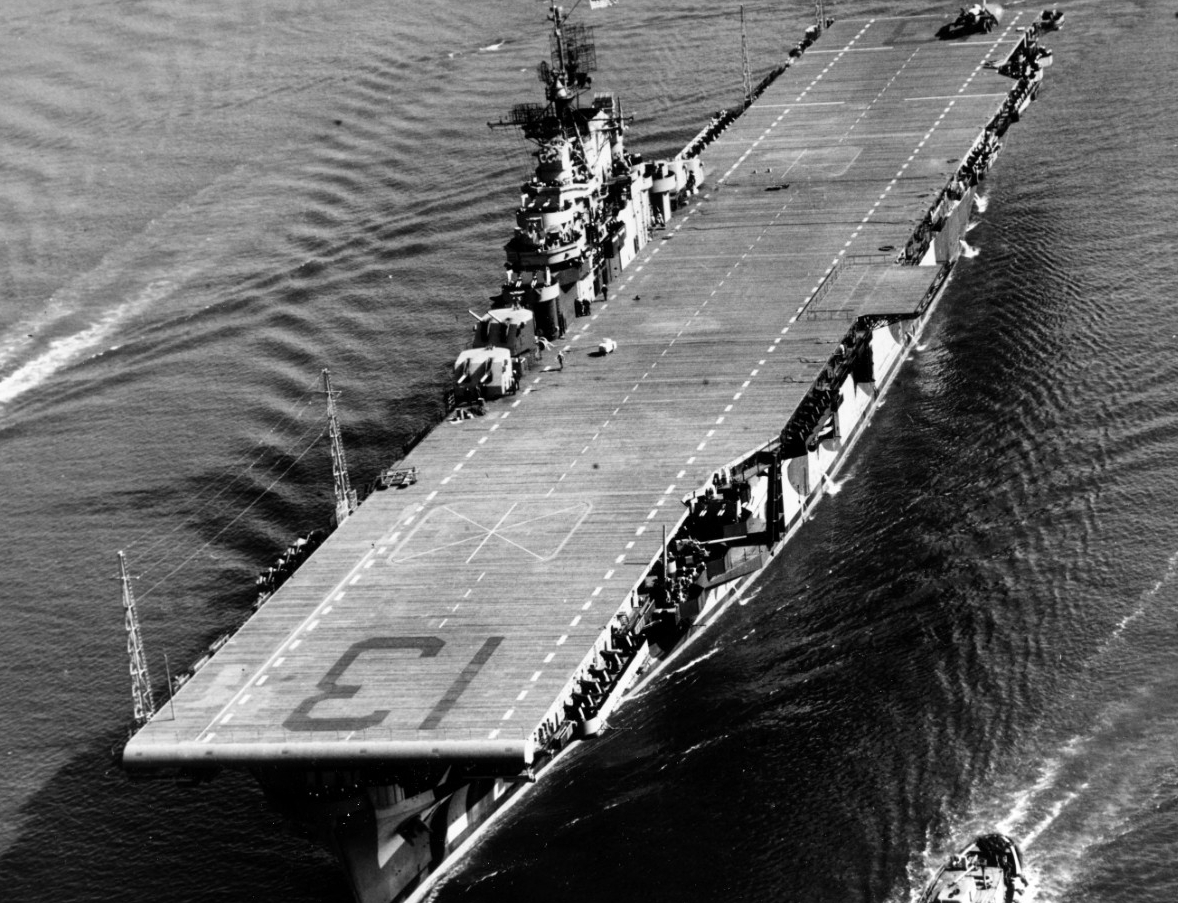
On the 27th of that month, the planes of Carrier Air Group (CVG) 13 (Cmdr. Charles C. Howerton in command) landed on board her flight deck for the first time. CVG-13 consisted of Fighting Squadron (VF) 13, flying a mix of 36 Grumman F6F-3 and F6F-5 Hellcats; Night Fighting Squadron (VF (N)) 77 Detachment B, flying four F6F-3N Hellcats; Bombing Squadron (VB) 13, flying 36 Curtiss SB2C-3 Helldivers; and Torpedo Squadron (VT) 13, flying 18 Eastern TBM-1C and Grumman TBF-1D Avengers.
The carrier got underway for the first time on 2 March 1944, steaming via Hampton Roads, Va., to a designated operating area in Chesapeake Bay. For the next 12 days, Franklin conducted trial runs and gunnery drills while the aviators of CVG-13 underwent a grueling series of landing qualifications. At the conclusion of the trials Capt. Shoemaker observed that “Long, hard hours for all hands have effected a teamwork which enables a deck load of combatant planes to be launched in an average of 13 minutes and 25 seconds.”
On 15 March 1944, Franklin returned to Norfolk and took on supplies and ammunition for her shakedown cruise. Five days later, escorted by the destroyers Wainwright (DD-419) and Rhind (DD-404), Franklin weighed her 15-ton anchors and shaped a course for the Port of Paria near Trinidad, British West Indies. Following a month-long shakedown in the Caribbean Sea the aircraft carrier returned to Norfolk on 21 April for an availability period.
With voyage repairs completed and stores replenished, Franklin got underway for her first wartime deployment on 5 May 1944. Escorted by Twiggs (DD-591), Leary (DD-158) and Cushing (DD-797), the carrier began her voyage to San Diego, Calif., via the Panama Canal. She transited the isthmian waterway on 11 May and then headed north in company with Task Group (TG) 27.7. Arriving off the coast of California on 19 May, Franklin and her task group participated in a mock battle with U.S. Army Air Force planes before eventually mooring at San Diego. Franklin then spent the rest of the month undergoing voyage repairs and preparing for her upcoming operations in the Pacific.
Accompanied by TG 19.7, Franklin quit the west coast on 1 June 1944, and made a fast voyage (steaming at an average of 23 knots) to Pearl Harbor, T.H., where she arrived on the 6th. The week following her arrival in Hawaiian waters, Franklin participated in several local exercises. During that time VT-13 became one of the first Navy torpedo squadrons to drop the “Mark XIII, Model 2A, Shroud-Ring Aerial Torpedo,” during a demonstration for higher command. On 16 June, the carrier reported for duty with TG 58.2, commencing her first mission as part of a fast carrier strike force. Voyaging as part of the reserve force for the Fifth and Seventh Fleets as they moved in on Saipan, Marianas Islands, Franklin steamed to Eniwetok Atoll, Marshall Islands, entering the circular lagoon there on the evening of the 21st.
With the invasion of Saipan well underway, Franklin stood out of Eniwetok on 30 June 1944, sortieing with TG 58.2, for an attack on the Bonin Islands [Ogasawara Shotō]. On 4 July, just 82 miles from Iwo Jima, Bonins, VF-13 launched a 16 plane fighter sweep, which encountered and destroyed three Japanese Mitsubishi A6M Type 0 carrier fighters (Zekes) and one Nakajima B5N2 Type 97 carrier attack plane (Kate). Subsequent strikes conducted throughout the day by VF-13, VB-13, and VT-13, sent 160 sorties against Iwo Jima and 30 more against Haha Jima, Bonins.
Japanese gun emplacements, airfields, hangars, barracks, and shipping at both locations underwent heavy bombardment, however “intense and accurate AA fire of all types was encountered during the first four strikes,” and CVG-13 suffered four casualties in all. Two of VF-13’s F6F-5s (BuNos 58357 and 58321) and two of VB-13’s SB2C-3s (BuNos 18726 and 18704) were lost. In all four of the crashes, all pilots and aircrewmen were rescued with the exception of Lt. Milton J. Bonar and ARM3c Albert D. Lenthal.
At nightfall on 4 July 1944, Franklin proceeded to another launching point off Guam, Marianas. Shortly after fueling from the oiler Cimarron (AO-22) on 6 July, Franklin steamed to a strike position 225 miles off the northeast coast of Japanese occupied Guam. At 1403, VF-13 sent out a fighter sweep against Orote Field, Guam, and damaged several enemy buildings. However, the attack encountered heavy anti-aircraft fire and resulted in one of the lead F6F-5s (BuNo 58377) being shot down. Lt. William T. Gove, the pilot, was “observed getting into his rubber boat two miles north Ritidian Point,” and he, along with his wingman, Ens. Roger L’estrange, were later rescued by a Vought OS2U-2 Kingfisher flying from the heavy cruiser Boston (CA-69).
The following morning, on 7 July 1944, Franklin arrived at an alternative striking position southwest of Guam. Once in position, CVG-13 aircraft commenced a daily series of airstrikes against Guam and Rota, which swept Japanese fighters from the skies and destroyed enemy military installations and fortifications ashore. The tempo of the air bombardments, which were sometimes accompanied by surface fleet shelling, steadily grew more intense, finally reaching a crescendo on 21 July when U.S. amphibious forces commenced an invasion of the island. Franklin’s aircraft continued to support the invasion through 22 July, until, “due to an exhaustion of the bomb supply,” the carrier had to head north to Garapan Anchorage, Saipan.
Franklin reached her destination later that same evening and dropped her hook at berth 23. The carrier re-fueled and re-provisioned her ordnance supply overnight and then just after sunrise the following morning, formed up with TG 58 and began steaming to the southwest for an air assault on the Palau Islands. In position on the afternoon of 25 July 1944, VF-13 launched a 16-plane fighter sweep, which splashed three airborne Japanese aircraft and damaged several others on the ground at Babelthuap [Babeldaob] Airfield. The next day, on the 26th, Franklin’s air group conducted four strikes against the islands of Babelthuap, Koror and Malakal, wreaking havoc on Japanese shore installations and shipping. At the conclusion of the day’s strikes one of VF-13’s Hellcats (BuNo 58361) “spun in while landing,” resulting in the death of the pilot, Ens. Robert H. Martin.
At 0645 on 27 July 1944, Franklin’s planes began one of four additional air strikes launched against the Palau Islands. The aerial bombardment destroyed “air facilities, AA positions, harbor installations… and left Koror Town ablaze.” In addition to the bombings, the planes of CVG-13 completed hundreds of photograph reconnaissance flights. On the morning of the 28th, Franklin’s task force steamed northeast towards Saipan and later that day anchored at Garapan Roads for replenishment. Underway on 29 July, Franklin began operating with TG 58.1 and at 1831 on 1 August, anchored at berth Able-32 at Garapan.
Departing the anchorage at Garapan on the afternoon of 2 August 1944, Franklin, in company with her task group, shaped a northerly course bound for the Bonin Islands. Steaming 105 miles from Chichi Jima, amid “foul weather and rain squalls,” planes of CVG-13 commenced their first strike of the day at 0526. Franklin’s planes strafed Japanese shipping and airfields causing significant damage, but the venture cost her air group several planes. One Helldiver (BuNo 19187) piloted by Lt. Cmdr. Carl B. Holmstrom, and two Hellcats (BuNos 58315 and 58371) piloted by Lt. (j.g.) Ancil C. Hudson and Ens. Roger W. L’estrange, respectively, were lost to Japanese anti-aircraft fire. All the pilots were killed in action. Further bad weather forced the cancelation of additional strikes against Chichi Jima and the task group shaped a southeasterly course headed for Eniwetok, Marshalls. On the 9th, Franklin dropped her hook 700-yards west of the anchorage at Eniwetok.
Shortly after anchoring, Franklin began an upkeep and recreation period. The last of her crew’s recreation parties returned from the white coral sands of Runit Island on 27 August 1944. The following day, “with smooth seas and clear skies,” Franklin put back out to sea as the flagship of TG 58.4, to conduct exercises, after which she shaped a course for the embattled Bonins with the rest of Task Force (TF) 38.
On 31 August 1944, Franklin, operating as the flagship for TG 38.4, arrived in her assigned strike area 145 miles off the beaches of Iwo Jima. Shortly after her arrival, 29 Hellcats from VF-13 took off for a fighter sweep against the island and subsequently destroyed ten airborne and ten grounded Japanese planes. Several of the Hellcats also sank auxiliary minesweeper No. 8 Toshi Maru near 25°00'N, 141°50'E, as well as the merchant cargo ship Suruga Maru near 24°46'N, 141°19'E.
The next day, on 1 September 1944, Franklin’s aircraft again bombed enemy facilities and shipping in the vicinity of Iwo Jima. The attacks resulted in the loss of one TBM-1C (BuNo 46085). Ens. Thomas Keene, USNR, AOM3c James T. Stovall, and ARM3c James T. John, survived the crash after making a water landing 15 miles east of the island. The submarine Finback (SS-230) later rescued them at sea and reported “all hands in good condition.” Additional air attacks on 2 September resulted in the destruction of an estimated 11 airborne and 41 grounded enemy planes, however despite the damaging casualties the Japanese defenders “were still shooting back.”
Quitting the area for replenishment on 3 September 1944, Franklin anchored briefly at Saipan on the 4th and then got underway for Yap [Wa’ab] Island on the 5th. Bearing 190 miles from her target on 6 September, VF-13 launched a fighter sweep of 18 planes at 1303, which located no enemy aircraft and found the island to be “in shambles from previous bombings.” Nevertheless, over the course of the next two days the carrier’s air group executed multiple bombing raids on the island and encountered some resistance. During an air strike on the 8th, Ens. Robert E. Slingerland flying an F6F-5 (BuNo 58140), was shot down while strafing Japanese gun positions. Ens. Slingerland managed to make a water landing approximately three miles west of Yap and was rescued the following morning by the destroyer Swanson (DD-443).
On 9 September 1944, “Task Group 38.4 left Yap, desolate and battered,” and headed toward the Palau archipelago. Arriving within striking distance of Peleliu Island on the 10th. Franklin’s air group then began bombing the island, conducting four or more air strikes a day for the next five days in order to “soften the island’s defenses,” in preparation for an amphibious landing planned for the 15th. The air group suffered multiple losses during the attacks. In the course of the strikes on the 10th an F6F-3 (BuNo 42550) piloted by Ens. Norman E. Drouin, USNR, and an F6F-5 (BuNo 58980) piloted by Ens. Jean P. Parent, USNR, were shot down by enemy anti-aircraft fire over Peleliu airfield. Both Hellcats were “last seen to crash on the island,” and neither of the pilots were recovered.
The worst loss of aircraft during the operation actually occurred as a result of an accident that took place on 12 September 1944. Amid rain and poor visibility, a twilight patrol of four night fighters returned at about 2035, and one of them made a poor landing, consequently drifting up the deck and crashing into several other parked planes forward of the carrier’s island. As a result, there was “a complete loss of a night fighter (BuNo 58010), two SB2C-3s (BuNos 19154, 18743) and two TBM-1s (BuNos 46074, 73167).” Fortunately, no one was killed in the incident.
The day before the invasion of Peleliu, Franklin’s bombardment efforts were further amplified by the guns of several U.S. cruisers and battleships, which in concert, reduced beach defenses on the island to rubble. On the morning of 15 September 1944, waves of assault marines landed on the beaches and although they encountered little initial resistance, the Japanese defense eventually stiffened. During the entirety of the day on both the 15th and 16th, Franklin’s air group worked tirelessly to maintain air superiority, suppress enemy shipping, and bomb defensive fortifications. Japanese resistance became so tenacious however that a landing at Angaur Island, Palau, on the 16th, was postponed until Peleliu could be pacified.
Franklin spent 17 September 1944, re-fueling at sea and then for a majority of the day on the 18th, conducted air strikes on Peleliu Island and Angaur Island. Late in the afternoon, Franklin, accompanied by the other ships of TG 38.4, set a course for Manus, Admiralty Islands. The carrier arrived at her destination on 21 September, and shortly thereafter, 29 planes from VB-13 proceeded to Ponam Field, Manus, “to be turned in for replacement bombers.” At 0622, Franklin anchored in berth 16, Seeadler Anchorage, Manus. In the course of the next two days, the carrier “received outstanding logistics service from Service Squadron Ten.”
Weighing anchor at 0916, on 24 September 1944, Franklin, still serving as the flagship for TG 38.4, began steaming for a designated station northwest of the Palau group. The carrier arrived in her designated area on the 27th and awaited a rendezvous with several other carrier groups. Biding her time, Franklin engaged in daily patrols and exercises in the area. On the 30th “extremely foul weather caused the cancelation of Franklin’s patrols,” but the carrier continued her mission. Going into the first week of October the weather continued to deteriorate as a full-blown typhoon moved towards the Formosa and Okinawa area. On 9 October, Franklin and her task group began steaming northward, trailing the storm, in order to rendezvous with TGs 38.1 and 38.3 in the vicinity of Okinawa.
Franklin arrived in her designated position, located some 100 miles south of Okinawa, on 10 October 1944. Just before dawn VF-13 launched a 12-plane fighter sweep against Okinawa and then twenty minutes later the air group commenced the first of two bombing runs, which in all, sent four deck loads of torpedo planes, fighters, and dive bombers out against the enemy. Torpedo planes targeted shipping at Naha, and Okinawa, and dive bombers armed with “rockets and incendiaries hit parked aircraft on the airfields and hangers,” as well as shops and harbor facilities. In the course of the attacks, a Zeke shot down an F6F-5 Hellcat (BuNo 70413) and killed the pilot Lt. (j.g.) Joseph L. Heinrich. Anti-aircraft fire also brought down an SB2C Helldiver (BuNo 19506), killing Ens. Thomas G. Norek, USNR, the pilot, and ARM3c Harry J. Steele, USNR, his aircrewman.
The following day, the carrier shaped a southerly course in order to attack an airfield located at Aparri, Luzon, Philippines. Arriving within 314 miles of the target at 1231, VF-13 launched a fighter sweep and destroyed several enemy aircraft on the ground. After recovering her fighters, Franklin steamed in company with TGs 38.1.2 and 38.1.3, towards Formosa [Taiwan].
Arriving within striking range of Formosa on 12 October 1944, CVG-13 launched a fighter sweep, as well as the first of several bombing runs. Strike Able surprised Japanese forces but resulted in the loss of a Helldiver (BuNo 19624), shot down over the target. The pilot, Lt. Rupert J. Weber, USNR, and ARM3c James L. Hatt, his aircrewman were both killed. Strike Baker commenced at approximately 0840, and Strike Charlie at 1110.
Planes from the last strike of the day were recovered at 1715, with the exception of one TBM-1C Avenger (BuNo 73233) from VT-13. The Avenger, piloted by Ens. Robert F. Jones, had its right wing shot off and the plane then crashed into the harbor at Takao, Formosa. Jones and AMM3c Grier P. Osborne and ARM3c Stanley P. Rajza, his aircrew, all died as a result of the crash. In all, Franklin’s air group shot down five enemy planes in the air “and at least as many on the ground.” They also claimed to have sank two cargo vessels, and severely damaged ground installations and aircraft facilities in the target area.
Heavy aerial bombardment of the Formosa area continued on the morning of 13 October 1944. Throughout the course of the day, CVG-13 launched one fighter sweep and four bombing runs “hammering enemy installations.” The day’s exploits resulted in one plane loss. During Strike Baker Lt. (j.g.) Richard H. Bridge was killed after his Hellcat (BuNo 70331) was shot down by enemy anti-aircraft fire near Garambi Lighthouse, Formosa.
Late in the afternoon, just after Franklin recovered the last of her planes from the final air strike, a “large number of enemy bogies,” appeared on her radar. All hands went to general quarters and eight Hellcats roared off the flight deck to supplement the Combat Air Patrol (CAP). At approximately 1827, four Mitsubishi G4M Type 1 land attack planes “carrying one torpedo each,” emerged from the horizon and attacked the task group. Two of the Bettys managed to launch their torpedoes at Franklin but both missed their mark, thanks in large part to the skillful ship handling of Capt. Shoemaker.
Although the Japanese planes were ultimately shot down, three by anti-aircraft fire and one by a CAP Hellcat, they managed to inflict some casualties on the carrier. One of the enemy planes attempted to crash directly into Franklin but glanced off the flight deck, abaft of the island structure. The wrecked plane then slid across the deck and burst into flame before tumbling into the water off the starboard beam. AMM1c Harold L Stancil, ship’s company, was killed and ten others wounded. At 1850, shortly after they strafed a radar station near the southern tip of Formosa, the Hellcats that were scrambled earlier, landed back on board Franklin’s flight deck.
On the morning of 14 October 1944, TG 38.4 retired from Formosa, and shaped a southerly course headed for Aparri. In position by 0630, VF-13 launched eight Hellcats for a fighter sweep at 0639, followed by several bombing runs. The following day “steaming as before off the western coast of Luzon,” Franklin’s air group executed two attacks against Nichols Field in the Manila area.
At 1046, less than an hour after launching her first deck load of planes, “four Japanese fighters, Oscars [Nakajima Ki-43 Type 1 fighter], carrying two bombs each,” slipped through the carrier’s CAP and initiated an attack on Franklin. Two of the Oscars pulled out of their dive and jettisoned their bombs too early, missing the carrier entirely. Another scored a near miss and the fourth landed a hit which “struck the after port corner of the deck edge elevator.” The bomb killed SM3c James B. Rogers and S2c William Taylor of the ship’s company, as well as Lt. (j.g.) Harmon J. Hudson, a pilot from VT-13; 32 other men were wounded. Later that evening, Franklin scrambled 16 Hellcats to “intercept a large bogie.” The fighters eventually encountered a Japanese attack group of approximately 30 planes, 60 miles distant of the carrier. In the aerial action that followed, they claimed 26 of them.
Franklin spent the majority of 16 October 1944 fueling, after which, she continued battering Japanese targets in the Philippines in support of planned amphibious landings at Leyte. Steaming off the east coast of Luzon on 17 October, the carrier’s planes began their first of two strikes at 0559, targeting Clark Field. In the course of the attacks one F6F-5 Hellcat (BuNo 58375) “ran out of gas and made a water landing,” resulting in the death of the pilot Lt. (j.g.) Joseph Kopman, USNR.
On 18 October 1944, Franklin sent out two fighter sweeps and conducted three air strikes against targets at Manila, Philippines. In the evening, Franklin assisted two Helldivers from Enterprise (CV-6) that had run low on fuel. At 0614 the next day, Franklin’s air group launched a fighter sweep against Nichols Field and then beginning at 0638 commenced the first of three bombing runs on the Manila Bay area focused on suppressing Japanese shipping.
During Strike Baker one of VF-13’s Hellcats, (BuNo 58363) which had been engaged in aerial combat with enemy planes “was seen descending towards the ground in a slow spiral.” The subsequent crash resulted in the death of the pilot, Lt. Eric Magnusson. A TBM-1C Avenger (BuNo 73262) was also splashed during Strike Charlie while attempting a dive on a large tanker moored in the bay. The pilot, Lt. Edward W. Larkin Jr., USNR, and ARM3c Edward O. Hughes and AMM1c James D. Whittinghill, his two aircrewmen, died in the crash.
U.S. Sixth Army landings under the direction of Gen. Walter Krueger, USA, commenced at Leyte on 20 October 1944. Franklin’s aircraft directly supported troops of the X and XXIX Corps’ 1st Cavalry and 7th, 24th, and 96th Infantry Divisions as they moved ashore. CVG-13’s first strike of the day targeted San Pablo Airfield, Leyte, and the second “wiped out the village of Dagami.” The morning following her support of the invasion of Leyte, Franklin steamed to a “fueling area east of the Philippines,” as air support operations were taken over by other carriers.
On the evening of the 23 October 1944, Capt. Shoemaker received word that the submarines Dace (SS-247) and Darter (SS-227) had spotted and engaged a large Japanese naval force in the Palawan Passage, effectively commencing the Battle of Leyte Gulf (23-26 October). The Japanese ships that had been contacted were in fact part of a multi-pronged attack aimed at countering the U.S. landings at Leyte; Dace and Darter had stumbled upon just one component of the attack—Vice Adm. Kurita Takeo’s Central Force.
In response to the Japanese counterattack, Adm. William F. Halsey Jr., Commander, Third Fleet, ordered TG 38.2, TG 38.3, and TG 38.4 to move north to intercept the approaching enemy fleet. Steaming east of Samar Island on 24 October 1944, the first wave of Franklin’s planes left the flight deck at 0612 to conduct an “attack search over the Visayas.” Later that day at 0951, Franklin launched another 32 planes to attack the main body of the enemy fleet, which had been located in the area of the Sibuyan Sea.
Planes from Franklin, Enterprise, Intrepid (CV-11), and the small aircraft carrier Cabot (CVL-28) subsequently attacked and sank the Japanese super-battleship Musashi, south of Luzon, at 12°50'N, 122°35'E, and damaged the battleships Fusō and Yamashiro. Franklin’s planes also landed a fatal blow against the destroyer Wakaba, sinking her off the west coast of Panay, 11°50'N, 121°25'E. During the initial attack Lt. (j.g.) Marshall D. Barnett, Jr., USNR, and ARM3c Leonard Pickens, USNR, his aircrewman, were killed when their SB2C-3 Helldiver (BuNo 19452) was shot down. Japanese ships also shot down a TBM-1C Avenger (BuNo 46444), killing Lt. (j.g.) Richard H. Clive, USNR, and AMM3c Robert W. Bogert, and ARM2c Eugene E. Black, USNR.
Despite the previous day’s damaging attacks on the Japanese fleet, information received on 25 October 1944 indicated that a force of Japanese carriers was approaching the Philippine archipelago from the northeast. In response, Franklin and several other carriers steamed north to intercept the advancing task force—Vice Adm. Ozawa Jisaburō’s Northern Force which consisted of the carrier Zuikaku, small carriers Chitose, Chiyōda, Zuihō, and the converted battleship-carriers Hyūga and Ise.
During the early morning hours of 25 October 1944, aircraft from Essex and Lexington spotted and sank Zuikaku 220 nautical miles east-northeast of Cape Engaño—commencing the Battle of Cape Engaño. At 0641, Franklin’s planes made contact with the Japanese fleet. Aircraft from Franklin, Lexington (CV-16) and Langley (CVL-27) damaged Chiyoda and she was later “sent to the bottom by cruiser gunfire,” southeast of Cape Engaño. Accompanied by planes from Enterprise, Essex (CV-9), Lexington, and San Jacinto (CVL-30) another wave of planes from Franklin’s air group also helped sink Zuihō, located east-northeast of Cape Engaño at 19°20'N, 125°51'E.
In the wake of the battle, Japanese planes still managed to attack U.S. forces in the Leyte area, but American carrier and surface force attacks greatly disordered the IJN strike force. Franklin’s air group helped inflict tremendous casualties on the enemy but also suffered several of its own. During the initial attack on the Japanese fleet, Ens. Thomas P. Brooks’ TBM-1C Avenger (BuNo 73456) was shot down, and he and AOM1c Harold J. Shane and ARM3c Francis J. Ploger, his crew, perished. During strikes Charlie and Dog, anti-aircraft fire from enemy fleet units splashed two SB2C-3 Helldivers (BuNo 19521 and BuNo 19677). Lt. (j.g.) Donald A. McPhie, USNR, ARM2c Robert D. Chandler, Lt. John H. Finrow, USNR, and ARM1c Henry E. Borja were all reported missing and later determined to have been killed in action.
With the dawn of 26 October 1944, the Battle for Leyte Gulf drew to a close as U.S. Navy and Army Air Force planes pursued the retiring Japanese fleet. In need of provisions, Franklin broke off from the fight and steamed northeast of Samar Island to take on fuel and ammunition. The following day, on the 27th, Rear Adm. Ralph E. Davison, the commander of TG 38.4, ordered Franklin to move east of Leyte to launch air attacks against Japanese ships and installations in the Visayas and northern Luzon area. CVG-13 launched a morning fighter sweep and reportedly damaged two enemy destroyers south of Midoro. Later that evening the carrier also took on 20 replacement Hellcats, transferred from Lexington and Langley.
Franklin and the other carriers in her task group provided air support for troops on Leyte, and conducted daily searches for survivors of downed aircraft between 28 and 29 October 1944. In the course of operations on the 28th, VF-13 lost three Hellcats, “one to enemy aerial action,” and two others to landing incidents. Pilots Lt. (j.g.) Robert F. Brooks, (BuNo 41758), Ens. Chris N. Gibbs (BuNo 42837) and Ens. Benjamin J. Miles (BuNo 58248) were reported missing and later determined to be KIA. Bad weather on the 29th resulted in the death of another Hellcat pilot, Lt. (j.g.) Warren F. Wolf, whose plane disappeared while en route to Franklin from Leyte.
On 30 October 1944, Franklin briefly broke away from her air support duties on Leyte to conduct fueling operations off Samar Island. At 1405, VF-13 launched 12 Hellcats in response to an urgent request from a nearby fleet tanker that reported she was under attack by Japanese planes. Franklin’s crew went to general quarters and “no sooner had the fighters left the deck than Franklin was subjected to a bombing attack.” At the exact moment of the attack, the destroyer Bagley (DD-386) had been alongside Franklin taking on fuel, but quickly cast off. Six enemy planes identified as a mixture of Zekes and Yokosuka D4Y Suisei carrier bombers (Judys), came in at high speed “targeting the formation at about 3,000 feet.”
One of the planes, a Judy, “dove over Franklin,” just missing her starboard side, amidships. A Zeke, observed to still be carrying bombs then intentionally crashed into the carrier’s flight deck inboard of the No. 5 and No. 7, 5-inch mounts. A terrific explosion followed which caused a ferocious fire to sweep the nearby planes on the flight and hanger deck. A third low flying plane attempted to bomb Franklin, but narrowly missed the carrier’s starboard side. The Japanese pilot then crashed his plane into the after portion of the Belleau Wood (CVL-24).
Two other Japanese planes crashed into the water as a result of errant suicide dives and a third one was shot down by Franklin’s gunners just as it was attempting to crash into Enterprise. Approximately 20 minutes after the attack on Franklin began additional fires broke out on the hanger deck and swept the second and third decks between frames 110 and 150. “All hands turned to,” and at about 1530 the flight deck fire was finally extinguished with the hanger deck fire lingering on until 1625. By 1800, all fires on board the carrier had been arrested with the exception of some that were still smoldering below decks. In total, casualties included 56 killed and 60 wounded.
In the wake of the kamikaze attacks on 30 October 1944, Franklin and her task group shaped a course for Ulithi Lagoon, Caroline Islands. The battered carrier arrived at Ulithi on 2 November and anchored in berth 14. Franklin then underwent temporary repairs through 10 November, and on the 11th, at 1600 she got underway for Pearl Harbor. Arriving at Ford Island, Oahu, on 21 November, Franklin continued on to her primary destination on the west coast, arriving at the Puget Sound Navy Yard, Bremerton, Wash., on the 22nd, where she then entered dry dock on the 28th. The carrier “secured for overhaul and repairs of battle damage,” while her crew went on leave. It was at this time that CVG-13 permanently detached from Franklin leaving behind a notable legacy, which boasted an estimated 338 enemy planes damaged and/or destroyed, 409,500 tons of enemy shipping sunk and/or damaged and 3,971 combat sorties flown.
At 0420, on 3 January 1945, Franklin was “floated off keel blocks” and then moored starboard side to Pier 3D at Puget Sound. In company with her escort Wilkes (DD-441), Franklin steamed out to sea and conducted a structural firing test of her new 40-millimeter mounts while en route to California. On 4 February, following a three day cruise, she moored at the Carrier Pier at Naval Air Station, Alameda, Calif.
Shortly after her arrival at Alameda, Franklin’s new air group, Carrier Air Group 5 (Cmdr. Edwin B. Parker Jr., in command) touched down on the flight deck. Squadrons composing the new group included VF-5, flying 18 F6F-3 Hellcats and 1 F6F-5; Bombing Fighting Squadron (VBF) 5, flying 6 Chance Vought FG-1A Corsairs, 5 Brewster F3-1A Corsairs, 2 F4U-1C Corsairs, 21 F4U-1D Corsairs, and 1 FG-1D Corsair; VB-5, flying 6 SB2C-4 Helldivers, 2 SB2C-4Es, and 11 SBW-4E Helldivers; and VT-5, flying 8 TBM-3E Avengers, 2 TBM-3s, and 6 TBF-1C Avengers. Two Marine fighting squadrons, VMF-214 and VMF-452, both of which flew F4U Corsairs, also operated with VF-5.
Following pilot qualifications, Franklin voyaged to Pearl Harbor, mooring port side, to berth Fox-13 at Ford Island, on 13 February 1945. Several days later on the 16th, the carrier then got underway as part of TG 19.6, for air and gunnery exercises that went on through the 20th. Franklin returned to Pearl Harbor for a few days, and then steamed back out to sea on the 23rd. Her air group continued conducting rigorous plane and gunnery drills for the next week, which unfortunately bore witness to multiple aircraft accidents as many of the new pilots endeavored to hone their skills. On the 28th, Franklin returned to the anchorage at Pearl Harbor.
Underway at 0745 “for forward areas,” on 3 March 1945, Franklin departed Pearl Harbor in company with TG 12.2, consisting of Intrepid (CV-11), the large cruiser Guam (CB-2), the Bataan (CVL-29) and a number of destroyers from Destroyer Squadron 48. On 13 March, Franklin reached the Northern Anchorage at Ulithi and moored in Berth 21.
Designated as the flagship for TG 58.2 (Rear Adm. Ralph E. Davison, in command), Franklin sortied from Ulithi at 0800 on 14 March 1945, en route to conduct the first carrier strike of the war against the Japanese home islands of Kyūshū and Honshū, as well as to support troop landings at Okinawa. The following day her task group merged with three others to form TF 58 (Vice Adm. Marc A. Mitscher).
Arriving within 100 miles of the Japanese mainland on 18 March 1945, Franklin participated in combined task group air strikes that targeted the Japanese cities of Kagoshima and Izumi located on the southern end of Kyūshū. During the initial attacks, CVG-5 aircraft claimed at least 17 Japanese planes in the air, and seven others on the ground, in addition to damaging “an airfield, shipping and two locomotives.” In response to the U.S. strikes, the Japanese launched several counter air attacks, which resulted in Enterprise, Yorktown (CV-10) and several other U.S. ships being damaged by bombs.
Franklin’s most trying hour came on 19 March 1945. Preceded by a night of “recurrent alarms” at 0554 on the 19th, VF-5 launched a fighter sweep against Itami, Hyōgo Prefecture, and then at 0657 sent out a wave of bombers to target Japanese shipping at Kōbe Harbor. Franklin’s aircraft combined with the rest of TF-58 and inflicted significant damage on enemy shipping. In all they contributed to the destruction of submarine I-205 while still in dry dock, and damaged battleships Yamato, Haruna, and Hyūga; carriers Amagi, Hōshō, Ikoma, and Katsuragi; light carrier Ryūhō; escort carrier Kaiyō; heavy cruiser Tone; light cruiser Oyodo; submarines I-400 and RO-67; and escort destroyer Kaki.
At 0705, Franklin received a TBS message from Hancock (CV-19) warning of a “twin engine enemy plane closing on you from ahead.” The information was never relayed to the bridge but surface lookouts and sky controls were alerted. Three minutes later, at 0708, without radar warning, a Japanese bomber emerged from a bank of clouds “less than 2,000 feet, directly ahead,” of the carrier and commenced a low level-bombing run.
The bomber appeared so suddenly, and so close aboard, that “it was not seen from the bridge,” but was, nonetheless taken under fire by the forward 5-inch and forward 40-millimeter batteries.
Despite the gunners’ efforts, the plane managed to hit Franklin with both of its 550-pound, semi-armor piercing bombs. One of the bombs hit the flight deck at frame 69, centerline, and penetrated through to the hanger deck where it exploded on impact at frame 82. It is believed that this explosion instantly killed all the crewmembers located at the forward part of the hanger deck. The second bomb struck the flight deck “at about frame 133 and apparently exploded above the hanger deck at frame 142.” These explosions started a series of uncontrollable fires, which ignited planes that were in the process of taking off.
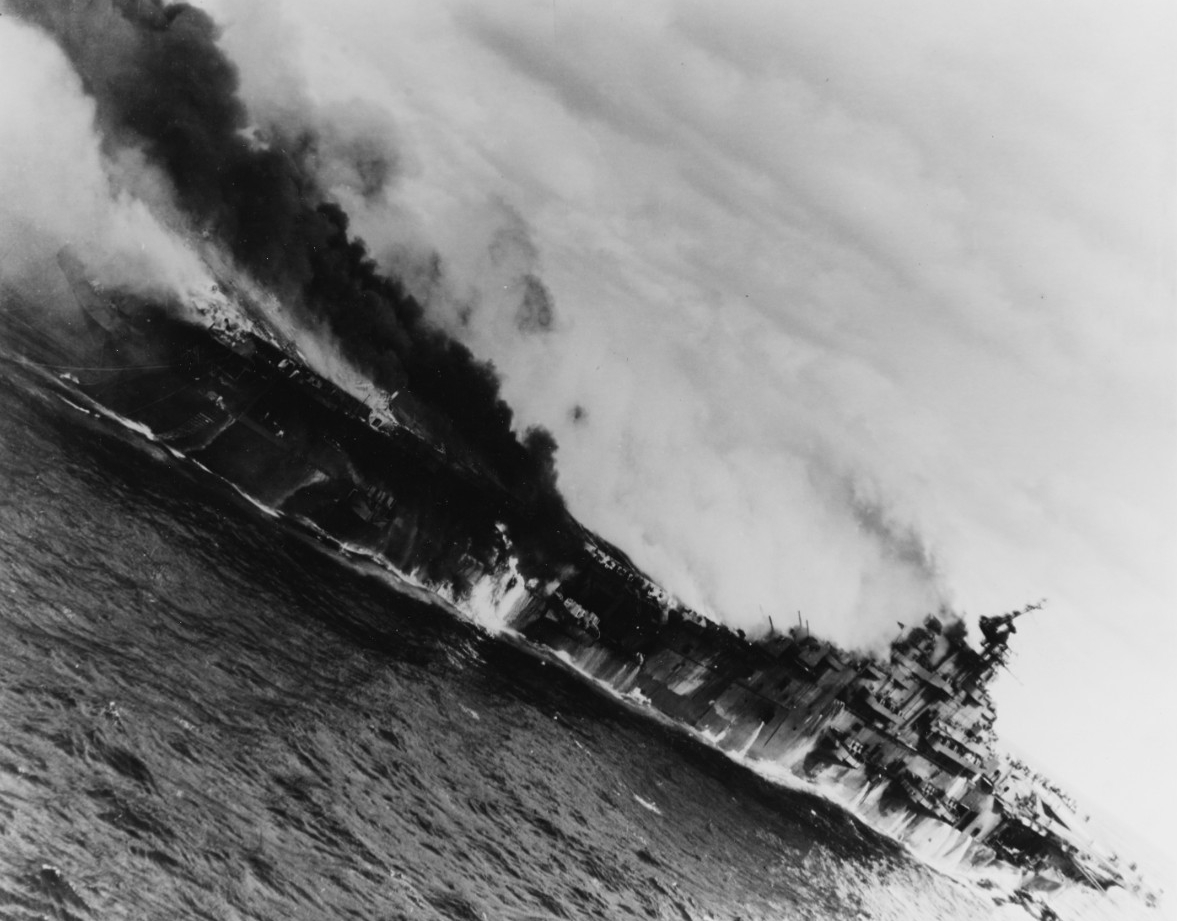
In writing his report on the attack Capt. Leslie E. Gehres, Franklin’s commanding officer, recalled that the “concussion of the first bomb knocked me down.” The initial explosions were followed by a five-hour long series of other heavier explosions that “turned up five bombers, 14 torpedo planes and 12 fighters,” all loaded with medium load, general purpose bombs and “Tiny Tim rockets.” Perhaps most detrimental to the situation, “fires from the hanger and gallery decks worked upward through the island and eventually got topside, igniting aircraft ammunition lockers.” By 0725, the ship had slightly steadied and was steaming at 16 knots. As he prepared to disembark Franklin, Rear Adm. Davison, the task group commander, advised Capt. Gehres to “pass the word to abandon ship.” Capt. Gehres however “did not take action” on the admiral’s suggestion, firmly believing that the ship could be saved.
At 0900, Franklin slowed to eight knots and Miller (DD-535) came alongside the carrier’s starboard quarter to evacuate Rear Adm. Davison and his staff. Shortly after Miller cleared, at about 0931, the light cruiser Santa Fe (CL-60) came alongside Franklin’s starboard bow, and began removing wounded sailors that were gathered in the vicinity of the forecastle. In addition to the 103 wounded, nearly 795 other sailors were evacuated to Santa Fe. The carrier took on a list of about three degrees to starboard, and the announcing systems stopped working. At 1000, “the ship lost all headway and lay dead in the water.” Meanwhile, Hickox (DD-673) and Miller assisted in picking up hundreds of other survivors that had been either driven or blown overboard by explosions and fires.
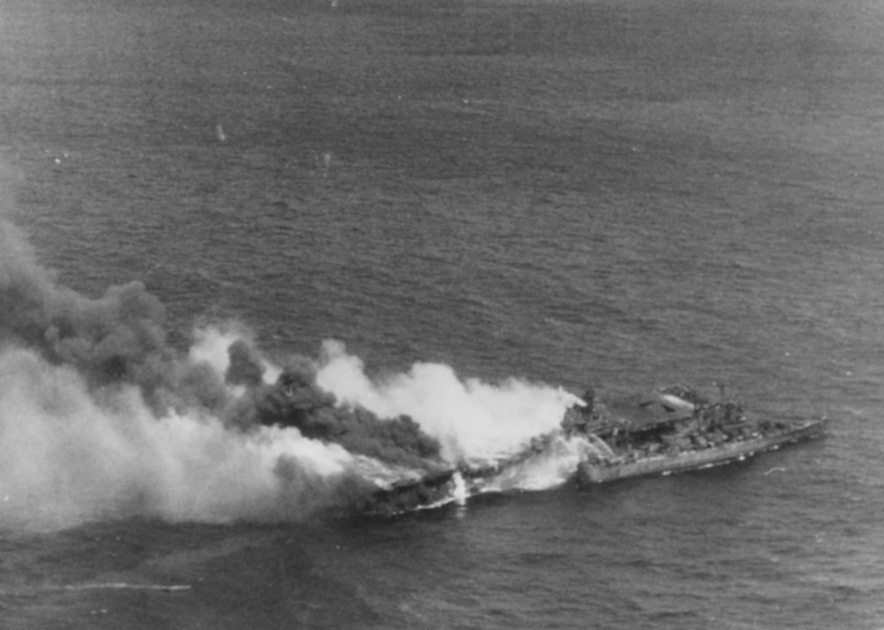
Despite the evacuations and massive casualties, 106 officers and 604 enlisted sailors voluntary remained on board Franklin determined to keep her afloat. A number of men distinguished themselves during the tumult but perhaps foremost among these were Lt. Cmdr. Joseph T. O’Callahan, USNR, the ship's Roman Catholic chaplain, and Lt. (j.g.) Donald A. Gary. Despite the chaos and destruction of the attack, Chaplain O’Callahan emerged as a particularly “soul-stirring” figure who, “seemed to be everywhere.” Survivor accounts of his deeds indicate that he gave “Extreme Unction to the dead and dying, urging men on and himself handling hoses, jettisoning ammunition and doing everything he could to help save our ship.” The image of the cross, painted on his helmet, became etched into the memories of those who watched as he moved through the carnage with his head slightly bowed as if in a constant state of prayer.
Lt. (j.g.) Gary’s gallantry in the tragedy proved no less conspicuous. Choking on smoke in a compartment of the ship, he tenaciously searched for an exit and following a number of failed attempts, eventually managed to lead nearly 300 of his shipmates to safety. He then joined fire-fighting parties as they combatted an inferno that enveloped the hanger deck. Amid these conditions, he braved extreme hazards by entering the number three fireroom to raise steam in one of the boilers. Chaplain O’Callahan and Lt. (j.g.) Gary, each received the Medal of Honor for their heroic conduct that day and have also subsequently had ships named in their honor.
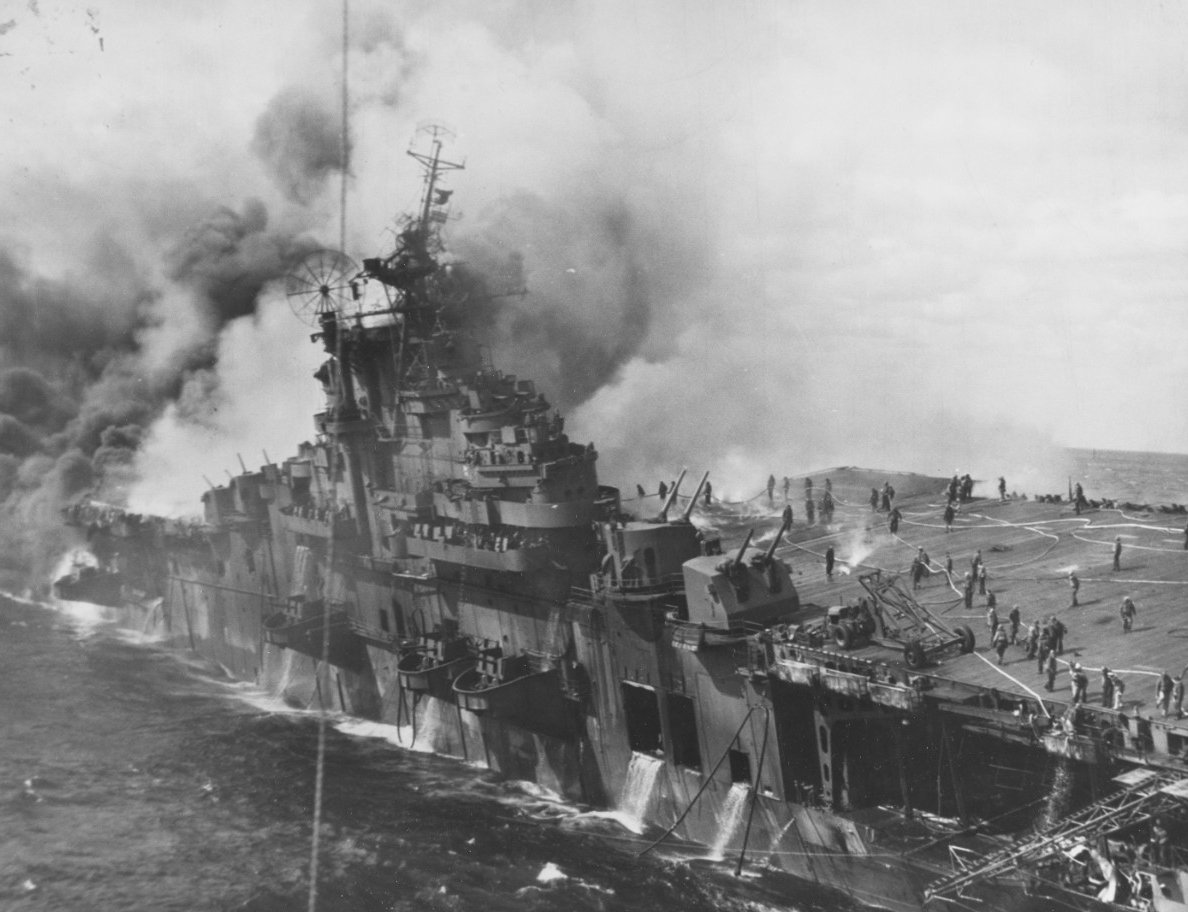
At approximately 1004, the heavy cruiser Pittsburgh (CA-72) “shackled a towing wire to the outboard end of Franklin’s starboard anchor chain,” and Hellcats from Enterprise provided air cover. The beleaguered carrier made slow progress through the waves and despite the fact that most of the fires on board were brought under control; she developed a 13° list to her starboard. Struggling through the water then just 50 miles off the coast of Japan, Franklin remained in great danger. In fact, only two hours into her tow she was attacked by a Judy, which fortunately, was driven off by anti-aircraft fire and her CAP.
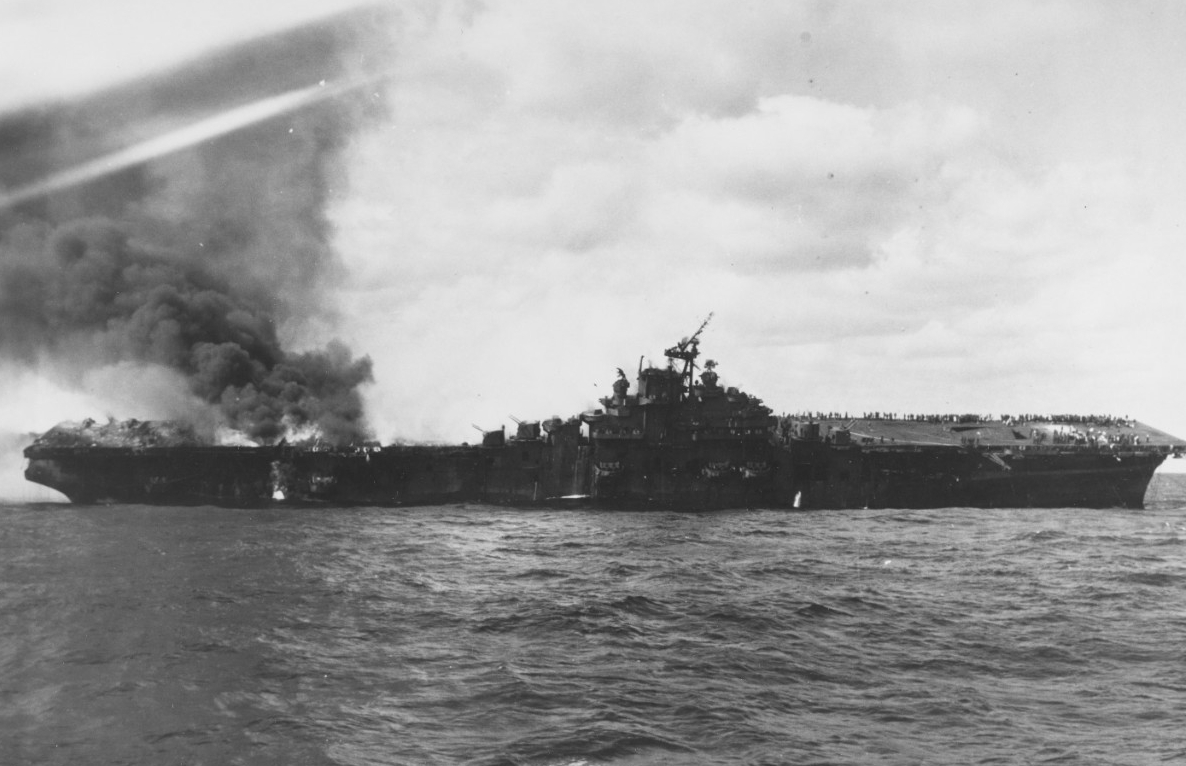
Capt. Gehres’ conviction, fortified by the valiant efforts of Franklin’s sailors ultimately saved the carrier from a watery grave and, quite fittingly, she thereafter became known as “The Ship That Wouldn’t Die.” Nonetheless, Franklin’s tragic bombing had resulted in a devastating number of casualties. Including her air group, 796 men were killed and 265 wounded.
Still under tow on the morning of 20 March 1945, Franklin regained steering control in her pilothouse at 0930, and then at 1233 cast off her towline as she was able to make “15 knots under her own power.” Entering Ulithi Lagoon in a column on 24 March, Franklin’s crew stood “in straight ranks, chins up and heedless of the drizzling rain…” living proof of their captain’s words that “A ship that will not be sunk, cannot be sunk.” The following day, standing amid the charred wreckage of the carrier’s hangar deck, Chaplain O’Callahan led a memorial service for the dead.
On 27 March 1945, Franklin, able to proceed under her own power, began her voyage back to the United States. The carrier steamed from Ulithi to Pearl (27 March–3 April), Pearl to Colón, Panama (9–17 April) and then from Colón to New York City (19–28 April).
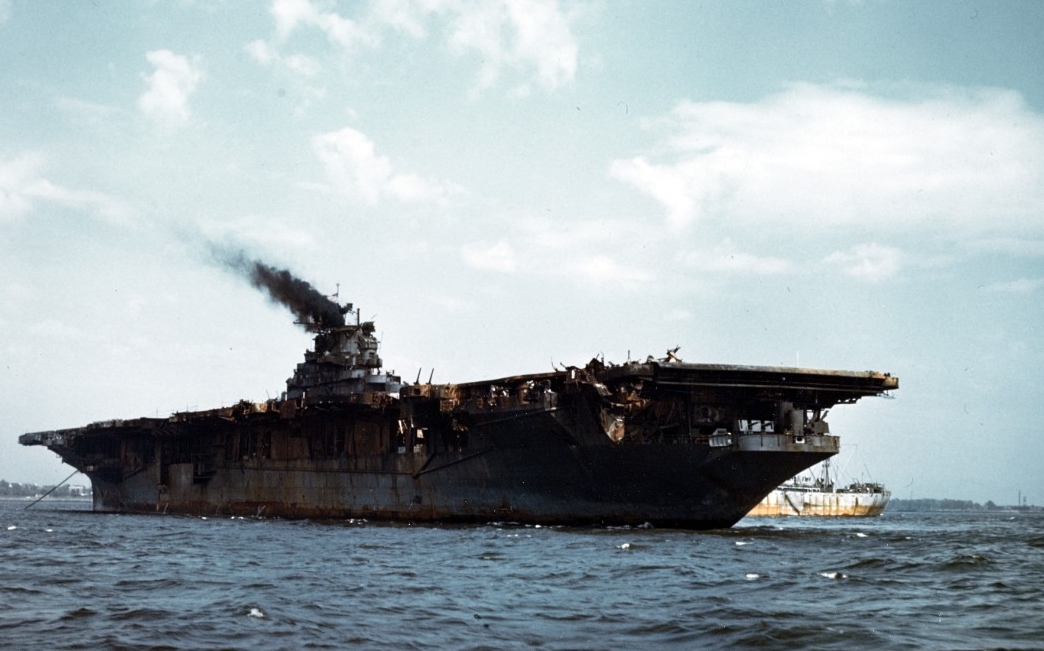
After arriving at Gravesend Bay, N.Y., on 28 April 1945, Franklin stood in near the Statue of Liberty on the 30th, and her crew “rendered an all hands salute.” The carrier then moored at the New York Navy Yard, Brooklyn, N.Y., and shortly thereafter her crew moved “ashore to barracks and prepared for rehabilitation leave.”
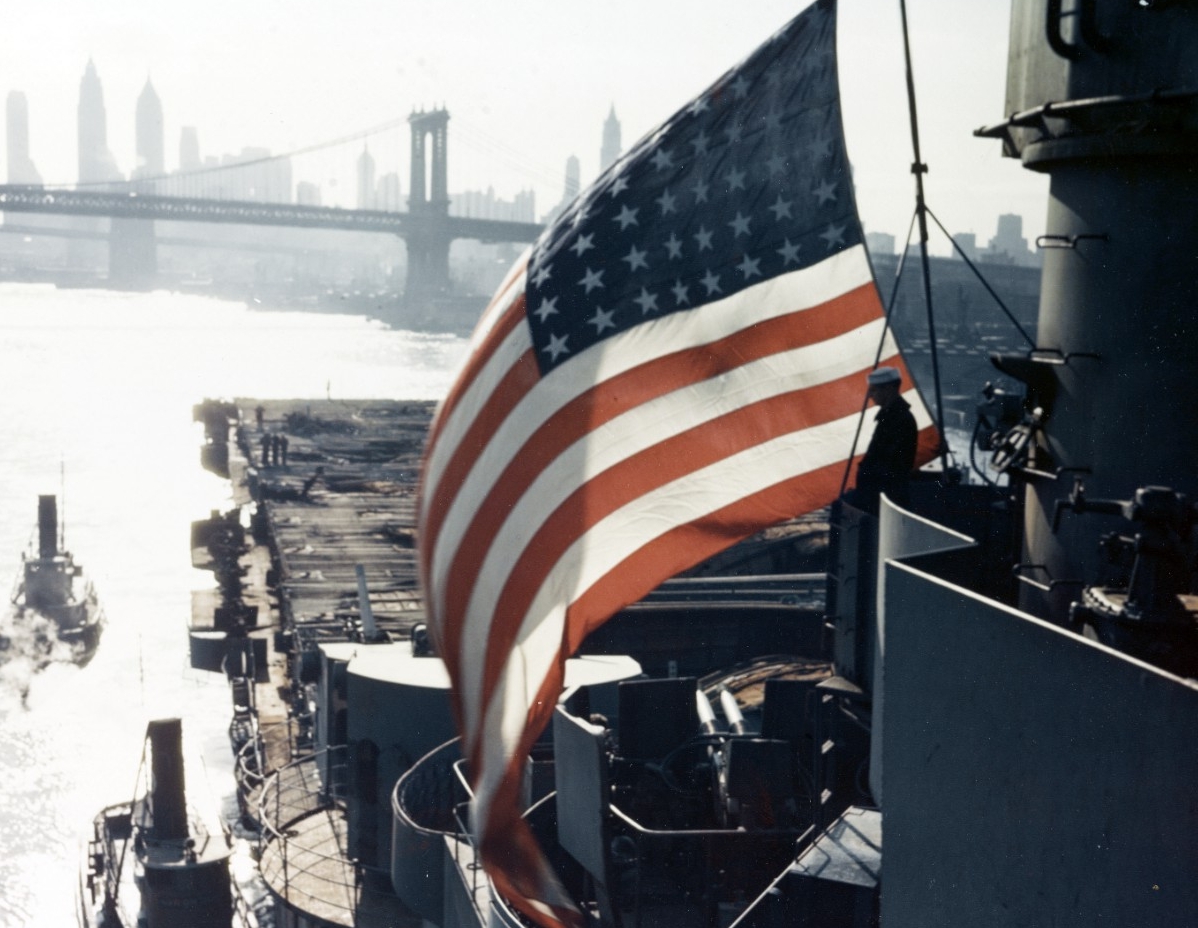
The following month, on 17 May 1945, the first awards for valor were presented to Franklin’s gallant crew. As a whole, her sailors became one of the most decorated crews in U.S. Navy history. Collectively they received two Medals of Honor, 19 Navy Crosses, 22 Silver Stars, 116 Bronze Stars, 235 Letters of Commendation, 347 Purple Hearts, and 808 Posthumous Purple Hearts.
When Japan surrendered on 15 August 1945, Franklin was still undergoing repairs. A few months later on Navy Day, 13 October 1945, she was opened up to the public and inspected by thousands of visitors. Her extensive repairs were finally completed on 15 June 1946, and two days later, she reported to the Atlantic Reserve Fleet for inactivation. On 17 February 1947, the carrier was placed out of commission at Bayonne, New Jersey.
“Mothballed” at Bayonne, Franklin never returned to active service but was nonetheless re-designated several times. On 1 October 1952, she became an attack aircraft carrier (CVA-13), on 8 August 1953 an antisubmarine warfare support carrier (CVS-13) and, finally, on 15 May 1959 an aircraft transport (AVT-8).
Stricken from the Naval Vessel Register on 1 October 1964, the U.S. Navy eventually sold Franklin, to Peck Iron & Metal Co., Portsmouth, Va., but then later re-possessed her due to a Bureau of Ships requirement for the use of her four turbo-generators. On 27 July 1966, she was sold again, this time to Portsmouth Salvage Company, Chesapeake, Va. She departed naval custody under tow of the Red Star Towing Company on the evening of 1 August 1966.
Franklin was awarded four battle stars for her service in World War II.
| Commanding Officers (CV-13) | Date Assumed Command |
| Capt. James M. Shoemaker | 31 January 1944 |
| Capt. Leslie E. Gehres | 8 November 1944 |
| Cmdr. Henry H. Hale | 29 June 1945 |
| Cmdr. Clarence E. Dickinson | 30 June 1946 |
| Commanding Officers (CVG-13) | Date Assumed Command |
| Cmdr. Charles C. Howerton | 1 November 1943 |
| Cmdr. Richard L. Kibbe | 8 August 1944 |
| Commanding Officers (CVG-5) | Date Assumed Command |
| Cmdr. Edwin B. Parker Jr. | 9 May 1945 |
| Cmdr. Richard K. Gould | 1 June 1945 |
Jeremiah D. Foster
21 November 2019


